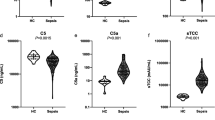Abstract
Determinations of C3, C4, and C5 concentrations by radial immunodiffusion, and assays for the activation products of C3, C3c and C3d by counter-immunoelectrophoresis, were performed on 80 infants. Seven nonbacteremic preterm infants with necrotizing enterocolitis (NEC) or probable NEC (PNEC) were found at the time of diagnosis to have a significantly lower mean concentration of C3 (P<0.05, 1-tailed) without C3 activation when compared to other noninfected preterm infants. Ten full-term and 63 preterm infants were studied prospectively during the first days of life, and were then followed for the postnatal development of localized or systemic infection. Assays for the detection of C3 activation products were negative in all these infants. Four preterm infants who developed PNEC after 5 or more days without clinical illness had low original concentrations of complement components. The pathogenesis of NEC may not involve primarily complement activation, and susceptibility to this condition may be related to pre-existing deficiencies in complement component concentrations relative to gestational age, or to defective activation of C3 in the presence of certain bacterial species and strains.
Similar content being viewed by others
References
Arroyave CM, Tan EM (1976) Detection of complement activation by counterimmunoelectrophoresis (CIE). J Immunol Methods 13:101–112
Arroyave CM, Taylor DG, Gallup P, Nakamura RM (1978) Screening test for complement activation by counterimmunoelectrophoresis. Am J Clin Pathol 69:440–445
Adinolfi M (1970) Levels of two components of complement (C4 and C3) in human fetal and newborn sera. Dev Med Child Neurol 12:306–308
Ballow M, Fang F, Good RA, Day NK (1974) Developmental aspects of complement components in the newborn. Clin Exp Immunol 18:257–266
Buetow KC, Klein SW, Lance RB (1965) Septicemia in premature infants. Am J Dis Child 110:29–41
Feinstein PA, Kaplan R (1975) The alternative pathway of complement activation in the neonate. Pediatr Res 9:803–806
Fenton LJ, Strunk RC (1977) Complement activation and group B streptococcal infection in the newborn: Similarities to endotoxin shock. Pediatrics 60:901–907
Fireman P, Zuchowski DA, Taylor PM (1969) Development of human complement system. J Immunol 103:25–31
1979 Host defenses in the fetus and neonate. Pediatrics (suppl) 64:705–833
Johnston RB Jr, Altenburger KM, Atkinson AW Jr, Curry RH (1979) Complement in the newborn infant. Pediatrics (suppl) 64:781–786
Johnston RB Jr, Stroud RM (1977) Complement and host defense against infection. J Pediatr 90:169–179
Kliegman RM (1979) Neonatal necrotizing enterocolitis: Implications for an infectious disease. Pediatr Clin N Am 26:327–344
Kohler PF (1968) Quantitative comparison of complement in the mother and newborn. Fed Proc 27:491
Mancini G, Carbonara AO, Heremans JF (1965) Immunochemical quantitation of antigens by single radial immunodiffusion. Immunochem 2:235–254
Miller JJ III, Hsu YP, Moss R, Kelomaa-Sulonen K, Osborne CL, Olds-Arroyo L (1979) The immunologic and clinical associations of the split products of C3 in plasma in juvenile rheumatoid arthritis. Arthritis and Rheumatism 22:502–507
Murillo GH, Goldman AS (1970) The cells of human colostrum. II. Synthesis of IgA and β1C. Pediatr Res 4:71–75
Norman ME, Gall EP, Taylor A, Laster L, Nilsson UR (1975) Serum complement profiles in infants and children. J Pediatr 87:912–916
Sawyer MK, Forman ML, Kuplic LS, Stichm ER (1971) Developmental aspects of the human complement system. Biol Neonate 19:148–162
Stevenson DK, Graham CB, Stevenson JK (in press) Neonatal necrotizing enterocolitis. 100 new cases. Adv Pediatr Vol 27
Stiehm E (1975) Fetal defense mechanism Am J Dis Child 129:438–443
Strunk RC, Fenton LJ, Gaines JA (1979) Alternative pathway of complement activation in full term and premature infants. Pediatr Res 13:641–643
Wilkelstein JA, Kurlandsky LE, Swift AJ (1979) Defective activation of the third component of complement in the sera of newborn infants. Pediatr Res 13:1093–1096
Author information
Authors and Affiliations
Additional information
This investigation was supported in part by a grant (RR-00081) from the General Clinical Research Centers Program of the Division of Research Resources, National Institutes of Health, and by a grant from the Kroc Foundation to John J. Miller, III
Rights and permissions
About this article
Cite this article
Stevenson, D.K., Hsu, Y.P., McMorrow, M. et al. Component concentrations and activation of the complement system in neonatal illness: A preliminary study of necrotizing enterocolitis. Eur J Pediatr 134, 255–259 (1980). https://doi.org/10.1007/BF00441482
Received:
Issue Date:
DOI: https://doi.org/10.1007/BF00441482




